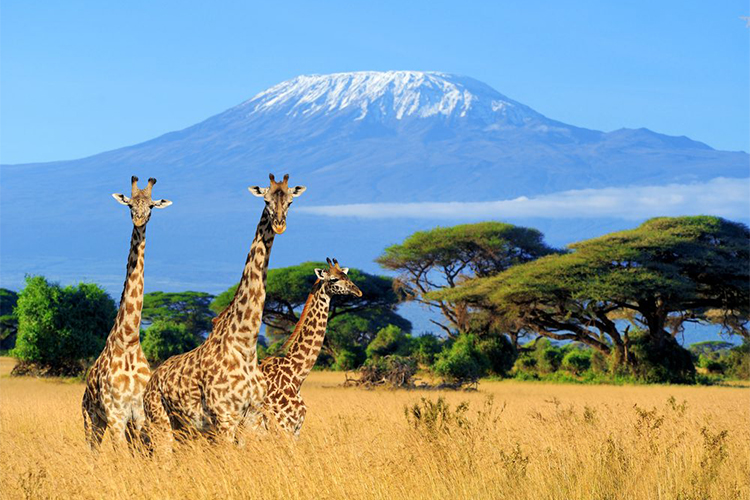The highest mountain in Africa, snow caped and world’s highest free standing volcano. It comprises of two dormant volcanoes (Kibo 5,895m a.m.s.l and Mawenzi 5,149m a.m.s.l) and one extinct volcano (Shira 3,962m a.m.s.l) respectively. The origin of the word is not well known but it said to be a combination of the Swahili word Kilima meaning “Mountain” and the KiChagga word Njaro, loosely translated as “Whiteness” giving the name “White Mountain”.
Its size is 1,712Km2 and was declared as a National Park in 1973, officially opened for tourism in 1977, declared a World Heritage Site by UNESCO in 1987 and Natural Wonder of Africa in 2013. Climbing to the top which is far up into the sky it’s a life time experience that no one can forget.
Climate
There are two rainy seasons in a year. The wet season is from March to May during which it rains around the mountain base and snow accumulates on its peak.
The dry season is from late June through September during which the nights are cool and the days completely clear.
The park is located at an altitude between 1700 m to 5895 meter with annual average rainfall ranging from 828 mm at alpine desert to 2500 mm at Montane forest.
Kilimanjaro National Park Trails
When it comes to talking about trails, really you are talking about routes up the mountain. There are seven different routes that provide opportunities for the ascent to the summit.
Southern Routes: Marangu, Machame, and Umbwe are the three routes that ascend from the south.
Western Routes: Lemosho, Shira, and Northern Circuit are the three routes that ascend from the west.
Northern Route: There is only one route that ascends from the north known as Rongai.
The Marangu Route, affectionately called the Coca Cola Route, is one of the more popular routes for the traditional visitor. It features one of the more gradual slopes as well as provides sleeping huts along the way. It is the oldest and most established route.
Approximately 25,000 people attempt the ascent each year. Altitude sickness and exhaustion are the primary roadblocks to a successful climb. Around 66% of those who attempt the trek up Mount Kilimanjaro are successful.
Getting there
The park can be accessed by road or flight via Kilimanjaro International Airport – about 45km to the west. The Park Headquarters and one of the ascending gates are at Marangu, about 41Km from Moshi town and 86km from Kilimanjaro International Airport. The other seven gates of Rongai, Machame, Londorosi, Lemosho, Kilema, Mweka and Umbwe are located around the mountain base and can be reached by road.
Preparing for Mt. Kilimanjaro
Although many attempt to summit the mountain only about 50% actually complete the climb. That doesn’t mean you can’t enjoy the experience as far as it takes you. Just be realistic about the mountain and its harsh conditions.
Of course, you should be in fairly good shape and not try and push the climb, giving yourself 6 or more days for the ascent. Still, the extreme cold and altitude can fell even the most experienced climber.
The symptoms of extreme altitude sickness – headache, nausea, diarrhea and loss of appetite – should be taken very seriously.
You’ll need waterproof cold-weather clothing and gear, a good quality sleeping bag and plenty of water bottles. The grandeur of Mt. Kilimanjaro is awe-inspiring but ultimately this mountain must be respected.
Discover Mt. Kilimanjaro
Visiting Mt. Kilimanjaro can be one of the great experiences of your Africa Holiday. Few summits share its fame or its power to conjure up the magnificence of our planet.
We have safaris departing from Arusha going to Mt. Kilimanjaro and other exciting Tanzania Parks. Embark on one of our mountain trekking experiences.

